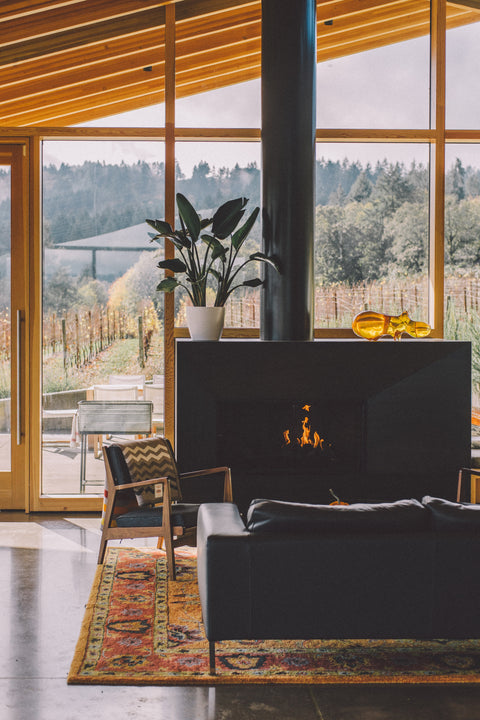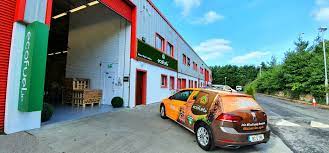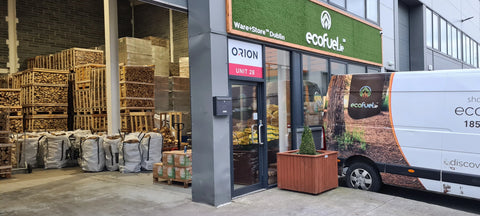Stove or Open Fires; It’s an age-old question like ‘Blur or Oasis’ or ‘Barry’s or Lyons Tea’. Everyone has a preference in this fireplace debate, with pros and cons on each side. But which fireplace benefits your home more? We’ve done a deep dive into the thermal properties of your classic open fireplace, and toasty closed in stove to better advise you on your perfect fireplace.
Wood Burning Stove
There are two ways a stove can heat your home; firstly with radiation heat and secondly with convection heat. Radiation heat emanates from the stove, heating surfaces near the fire. This type of heat can be intense directly in front of the stove but less so as you move further away. It is important with a radiation stove to get the correct energy output for the room and your home so the heat is not too overpowering for space. Something in the range of 5-8KW output is usually sufficient for most Irish living rooms.  With convection heat, the stove will warm the air around the fireplace and room. Hot air is lighter than cold air so it will rise up and push cold air down. In convection stoves the cold air will be sucked into the stove through a channel, it will warm as it rises through the fire and be pushed out through the top of the stove continuing the cycle of hot and cold air. Convection stoves will warm a much larger area than either a radiation stove or an open fireplace.
With convection heat, the stove will warm the air around the fireplace and room. Hot air is lighter than cold air so it will rise up and push cold air down. In convection stoves the cold air will be sucked into the stove through a channel, it will warm as it rises through the fire and be pushed out through the top of the stove continuing the cycle of hot and cold air. Convection stoves will warm a much larger area than either a radiation stove or an open fireplace.
Modern wood-burning stoves produce approximately 80% energy efficiency, this is primarily due to the high levels of combustion that occurs in the body of the stove. The closed design allows for controlled air intake which in turn allows the fire in the stove to burn considerably hotter. Burning hotter results in more thorough combustion of the fuel used which emits more energy in the form of heat. The heat achieved, and therefore the thermal efficiency for fuel used is incomparable to the heat generated in open fireplaces.

Open Fireplace
We’ve touched upon the crux of the issue with open fireplaces above but let’s deal with the matter head-on; they are not the efficient choice! Some studies have shown that only approximately 30% of the energy produced in open fire transfers as heat in the room, the remaining 70% of the heat is lost up the chimney. Now that we’ve addressed this let's look at why open fireplaces are not the most efficient choice.
The principles of radiation and convection heat we learned about earlier are in play with open fireplaces as well. An open fireplace will heat a room by use of radiation heat, the same way a stove would. The same drawback is present in open fires as it is only the area directly in front of the fire getting warmer, not so much the room as a whole. Given a stove will burn hotter than an open fireplace the radiant heat generated will be less than that of a closed stove. The convection currents in play from the heat being generated also work in a more inefficient way as most of the hot air generated go directly up the chimney causing a stronger pull of air through the fireplace also seen as the draught.
The draught in a fireplace plays a huge role in how the fuel in the fire burns. Given that by their nature open fireplaces are...well...open, there is a massive drought resulting in the fuel used burning considerably quicker. Quicker doesn’t always mean hotter or better, a quick burn will usually result in incomplete combustion of the fuel used meaning the full energy potential hasn’t been reached and your fire isn’t producing the heat it could in a more controlled environment.
Home Building Regulations in Ireland
For hundreds of years in Ireland, the hearth has been the heart of the home. A roaring fire was the quintessential Irish home feature. As time has passed however the inefficiencies of open fireplaces have come to light and regulations have been put in place to ensure that newly built homes are more airtight, energy-efficient, and perform to higher standards. In 2014 newly established Irish Building Regulations stipulate that new homes as part of developments must reach at least an A3 Energy Rating, increased from a B1 rating when the regulations were initially implemented. BER (Building Energy Rating) measures the energy efficiency of the house at the time it is built, ratings take into consideration the type of insulation used in the home, the ventilation systems used, and the efficiency of your heating system and indicates the level of carbon dioxide emissions in the home.
CO2 emissions from open fireplaces are considerably higher than those emitted from stoves. Studies have shown that when used to heat the same sized room open fireplaces emitted up to 15 times more CO2 than stoves. These emissions combined with an open chimney which will suck heat from a room thus creating a draught would cripple any energy rating tests being done in a home. Essentially, inserting an open fireplace into a new build in Ireland means that you would have to compensate for the inefficiency with a state of the art insulation to keep your home as efficient as possible or risk not getting your required compliance certificate.

Image Source: US Environmental Protection Agency
Another element to consider is the health implication of having an open fireplace. We mentioned the harmful CO2 emissions above but there is also particulate emissions to consider when deciding what, if any, fireplace would best suit your home. Particulate Matter (PM) is made up of the gases and dust emitted from combustion, in this case burning wood or solid fuels in your fireplace. PM is spread in the form of smoke or dust coming from the fire. No matter what type of fireplace you own you will be subject to some PM but choosing the correct type of fuel and efficiently burning it will reduce the levels you are facing. An open fire could produce up to 50 times more PM than a closed stove. This is due to the more thorough combustion fuel goes through in a closed stove and the fact that there is no barrier against smoke in an open fire.
Improving Efficiency in Open Fireplaces
You have an open fireplace and love it but you want it to be more efficient to heat your home, what can you do? There are a couple of really simple ways you can increase the efficiency of your open fire. They may not increase it to stove levels but you will definitely see a big difference in the toastiness of your home and in your fuel bill.
First and foremost; good chimney maintenance is essential! Keeping your chimney clean will allow for cleaner expelling of smoke and stop smoke from instead going into the room. Also investing in chimney insulation can prevent the build-up of creosote (a residue left over from the burning of solid fuels). Allowing creosote to build up in your chimney will result in inefficiency and again a smoky build up in your room when you light your fire.

Image Source: (l) Northline Express Chimney Damper. (r) firewood-for-life.com Chimney Pillow
If you do not already have one installed a chimney damper is the best tool you have at your disposal to combat lost heat in your home. This essentially operates as a plug when your chimney is not in use to stop heat from rising up the chimney and to stop down draughts from bringing cold air into your home. You simply open it when lighting your fire to allow smoke to go up to your chimney as usual and close it when your fireplace is not in use. Super simple stuff! Dampers can be fixed appliances in your chimney or they can be inflatable devices called ‘Chimney Balloons’.
An excellent device to get the most efficiency from your open fireplace is supplied by an Irish business called EcoGrate. Basically, EcoGrate provides a fireplace insert that sits into your fireplace grate and according to the designers generates “twice the amount of heat into the room for about half the amount of fuel”. How does it work? Pretty simple; you light your fire in the cast iron insert instead of your fire grate, cold air is then sucked in through a fan in the insert and travels through pipes in the insert and is blown out at the top of the insert. Using convection heat and radiant heat gives off similar efficiency to your closed wood burning stove. This is a more costly option coming in at €565-625 but it’s definitely cheaper than replacing your open fire for a stove with the good heat output and reduced fuel costs.

Image Source: www.ecograte.ie





